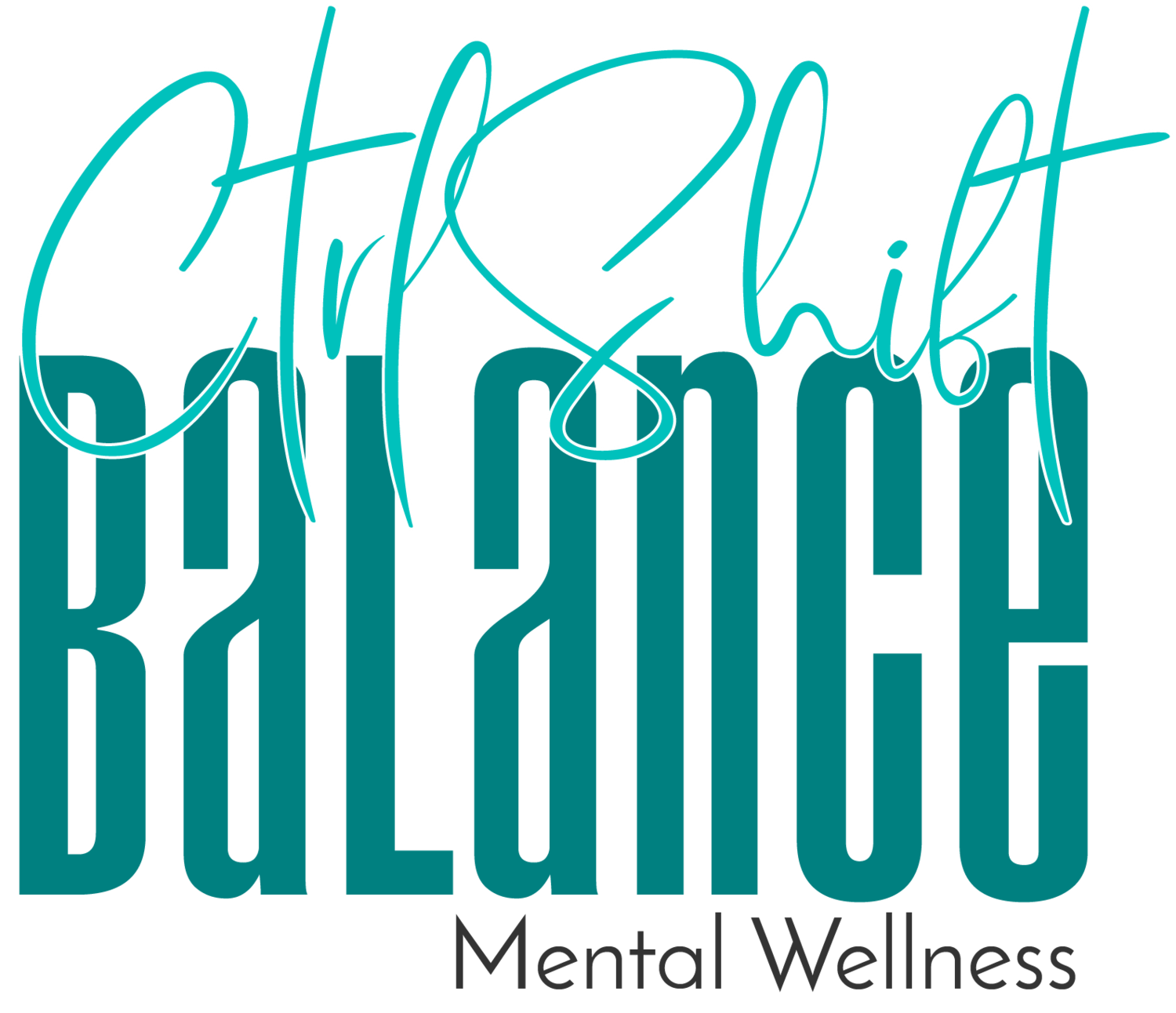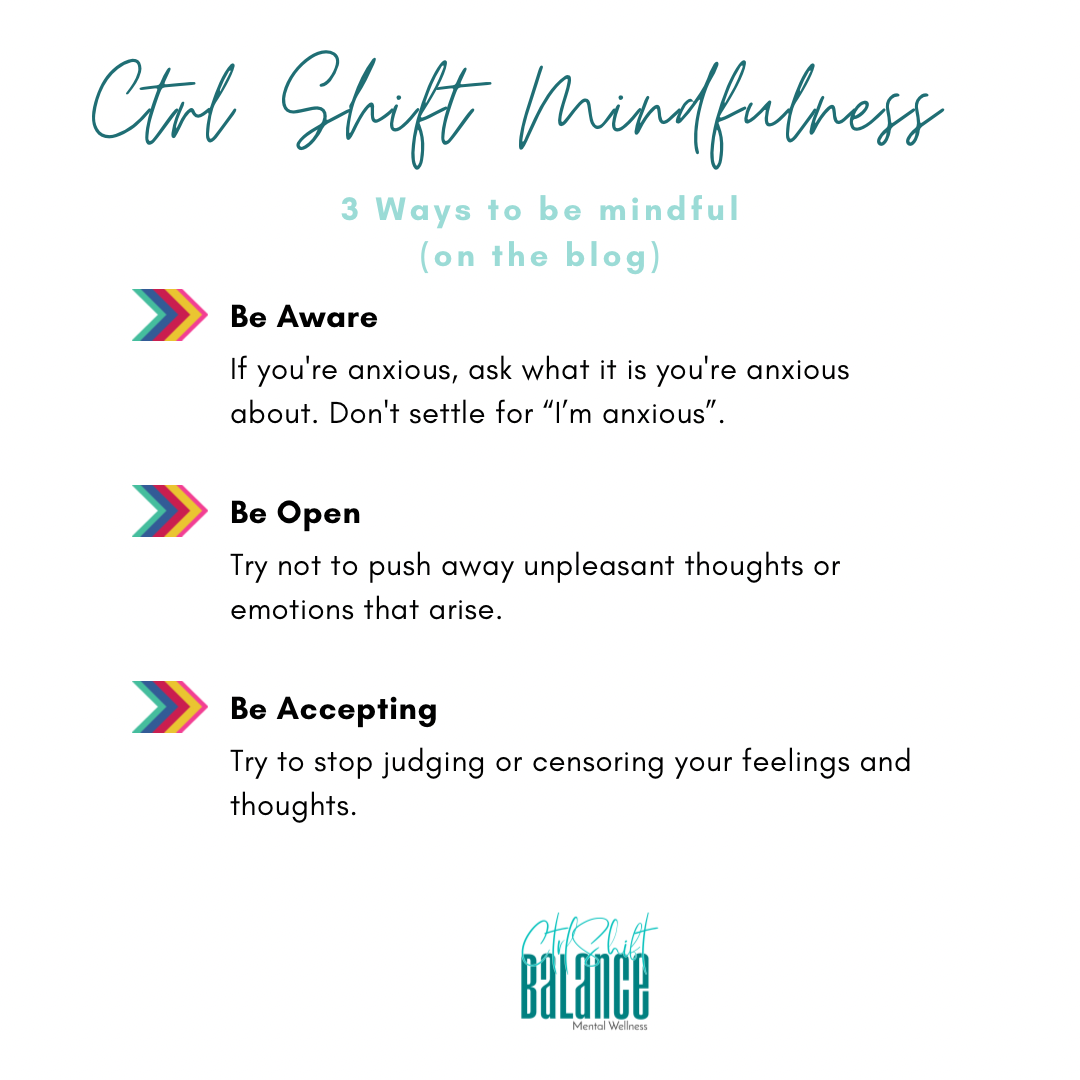
Ctrl Shift mindfulness
How to be more open, aware & present. Mindfulness—the practice of paying attention and staying present in the moment—has increasingly gained popularity in recent years. Perhaps this is because instead of spending even a second alone, staying present with our thoughts, we reflexively turn to our cell phones (I’m guilty of it at times) for entertainment, comfort, or distraction. Many of us are on our phones at work, in the bathroom - moments that in the past might have been spent unintentionally being mindful.
So how do we reclaim those mindful moments and again learn how to stay present, aware, and accepting of those moments?
Create Mindful Moments
Mindful moments are just small pauses in the business of life. They can be as short as a few breaths or as long as 10 or so minutes where we are actively present in the moment. Turn off the thoughts about the past or future and just notice what’s happening all around you. How do you feel? How do things look? How do things taste? etc...
The thing about being present and really paying attention is that we learn things about ourselves and our world that we might have been avoiding, perhaps with good reason. But we can deal with these thoughts and feelings once they come into the light.
When we try to just cope with emotions—like anxiety—the causes remain intact. Because mindfulness can help us better uncover and get at the causes, it can be a more effective way to increase well-being. But it’s important to note that mindfulness isn’t easy, so if it doesn’t work for you, that’s completely okay too.
Research suggests that people with severe trauma, depression, and other challenges like self-harm sometimes struggle with mindfulness. This is understandable since the roots of this emotional pain may be a lot harder to look at and deal with than other types of emotional pain. Please seek the support of a therapist if this is you and you want to use mindfulness.
How to Be Mindful
Even though mindfulness is theoretically possible to practice anywhere, that doesn’t mean it comes easy. Here’s some helpful tips:
To be more aware: If you're mad, ask what you're really mad at. If you're sad, ask what it is you're really sad at. If you're anxious, ask what it is you're anxious about. Don't settle for, "I'm mad at Devin because he was rude to me." Why does that rudeness matter? Why now? Why him? What is happening inside of you that makes you mad?
To be more open: Try not to push away unpleasant thoughts or emotions that arise. You might feel scared to cry in front of others or yell when you're angry. Try not to stifle those emotions. Instead, ask what might be leading you to stifle them. But also try not to generate excess emotions. Are you crying or yelling to get a specific reaction out of someone else? What are you hoping to achieve with your reactions? Try to stay present so you can just experience yourself as you are instead of trying to contort it into some kind of box.
To be more accepting: Try to stop judging or censoring your feelings and thoughts. Seriously, stop it! You may have heard judgy statements like “Boys don’t cry” or “You’re too sensitive” or “Get over it”, and you will, very likely, continue to hear these things. All you can do is refuse to judge yourself (or others), for having emotions. Emotions are natural and we all deserve ours.
Do a Quick Mindfulness Practice
Right now, try to create some negative emotions in yourself. An easy way to do this is to watch a movie or online video clip with a sad or emotional scene. Or if you’d like to challenge yourself, you could imagine something in your own life—for example, failing at something, being embarrassed in front of a crowd, or an injustice experienced by others that bothers you.
Once you have drummed up some negative emotions, stop thinking about the negative experiences and just be. See if you notice any interesting body sensations, emotions, or thoughts. Practice not ruminating on the experience but also not pushing the emotions away. Just be with yourself until your thoughts and emotions trail off.
If you finished this blog article feeling shaky, upset, or overwhelmed, mindfulness may not be for you. If, on the other hand, you feel more centered, calm, and content, keep using mindfulness to improve your life.
You may have additional questions on incorporating mindfulness in your day to day, let’s connect.
Your Partner in Balance,
Shayla Peterson
Ctrl Shift Your HABITS
Are you ready to create new habits?
Deciding to adopt new habits sounds good on paper, but in reality it can be challenging to put them into motion. How many times have you tried to exercise on a regular basis, only to find yourself back on the couch after few days or weeks. To be honest, I am guilty of it myself.
Let me share with you 7 strategies that will make implementing and maintaining new habits easier for your growth this Spring.
Chose the time & place. Many positive habits will be centered on a time, place or both. When you set a specific time and place to perform your new habits is key to become a regular part of life. EXAMPLE: Exercise in the morning before work or mediation in evening in the spare room.
Start with one habit at a time. It is natural to resist change or get super excited and want to implement everything all at once. Trying to change too much at once can create barriers towards lasting change. Simply Begin with a single habit. When you are performing and that habit is reliable, then add another. I encourage you to continue this until you have incorporate all the habits that you believe will relive your stress and promote balance in your life. Don’t forget to extend compassion as some new habits take longer than others. That is completely okay!
Start with the easier habit first. Yes, you have control over which habit that your will start with and with starting with the easier first, increases your odds of success. Start with the easiest to perform religiously to promote mastery. The little burst of success will encourage you to add more.
Understand your why. Consider each habit and what it will add to your life. If you are unable to see the benefit in a particular habit, you will be unlikely to stick with it. Remind yourself of the importance of the habit increases your chances in of being successful in this area whether is personal development, occupational, financial, recreational, etc.
Reward yourself. As you reach each milestone. Take a moment to cheer yourself on, dance party, praise break or reward just yourself. Keep it small but do it often (a weekly check is highly suggested).
Focus for 30 Days. It takes 21 to 30 days to create a new habit. Do everything that you can do to successfully get through the next 30 days. What would June 1 look like if you went hard on goals, new habits for 30 days or intentions. Whew! That will be a great feeling. I also want to share with you be easy if you miss a day or two, offer yourself compassion and get back on it on the next day.
Have Reminders. Habits are easier to create if we have something to remind us to do them. A good trigger is something that automatically happens each day. EXAMPLE: Get up, get dressed up, put on make up, drink coffee. What will your reminders look like?
Prepare. Setting new habits will require planning. If you are going to exercise in the morning, set alarm to wake up earlier, have your workout clothes at the end of the bed. Planning ahead and implement the necessary preparation to ensure your success.
New Habits can be challenging to develop, but strategies will make it go smoothly. You are invited to a free 15 minute consultation if you need a jump start on developing and reaching new habits in mental wellness.
Also visit the Wellness Shop for Ebooks and our most popular digital downloads for your mental wellness journey.
Your Partner in Balance & Wellness,
Shayla Peterson, LCSW, LISW-CP
Ctrl Shift Resilience
Last Sunday, I got a chance to be a panelist with 5 other accomplished professionals with Queen of Resilience SIP and SPEAK 2021. Can you image what theme focused on….RESILIENCE. It was amazing to hear several stories on how both men and women made a pivot during this era. Whew chile, 2020 was year of redefining what BALANCE looked liked. With increasing demands of work, becoming a home school parent, cancelling travel plans and moving to new state, there were days that were a struggle to say the least. I’ve learned that although it has been a struggle, it how we react to the struggle that matters. I want to share with you that it is possible to change the way that you reactive to negative circumstances.
Resilience is that amazing skill that helps you recover quickly from difficulties. If you are resilient, then when life knocks you down, you bounce back and you keep going. Sometimes life's challenges can even make you stronger.
So how do you become a more resilient person?
1. Reframe Your Catastrophic thinking
Catastrophic thinking is when we expect the worst possible outcome in a situation. For example, you may have lost your job and now believe that you will never be successful, and everyone will think you’re a failure forever. This may sound extreme. Most of us don’t catastrophize quite this much, but many of us do sometimes believe that the worst possible outcomes will come true. Although being aware of possible negative outcomes can be helpful for planning ahead, when we believe the worst will come true, we set ourselves up for unnecessary stress and poor resilience.
One way to break this thought pattern is to wear a pendant or carry a stone or other small object with you. Every time you find yourself imaging the worst — about a person, situation, or outcome — analyze the object. Name it’s color, shape, and details. This is just the right amount of distraction to help you calm down.
2. Recognize your Automatic Negative Thoughts
Often when bad things happen, we get stuck thinking about negative outcomes. We repeatedly think about what we could have done differently in the past, or how we are going to mess up again in the future. We ruminate on these events, because we mistakenly believe that thinking about our hardships over and over again will help us solve them. Unfortunately, negative thought cycles just get us caught up in our thoughts, instead of taking the actions we need to move forward.
To put an end to these negative thought cycles, which have become well-worn pathways in our brains, we need to short-circuit our thoughts mid-cycle. To do this, we can create a behavioral break or an action plan for what we’ll do when our negative thought cycles get going.
Exercise seems to be a really effective behavioral break. But if exercise isn’t possible (maybe you’re at work or with other people), try to do something else that uses both your mind and your body. For example, you could excuse yourself for five minutes to practice slow deep breathing. Deep breathing helps activate your parasympathetic nervous system, which can both calm you and reduce your stress levels.
3. Stand up to your fear.
Unfortunately, many of us avoid failure at all costs. We do so, because we are afraid of failure; we worry that people will think poorly of us if we fail, and we feel ashamed when we fail. But by treating failure like a disease to be avoided, we never give ourselves a chance to overcome challenges and practice resilience. As a result, we prevent ourselves from becoming more resilient. So how do you conquer your fear of failure so that you can start building resilience?
If you think failure is a threat, like many of us do, your body will prepare for a fight — and you’ll feel like you’re in a battle. On the other hand, if you choose to view doing something hard, something you could fail at, as a challenge, then you're more likely to think you are capable of handling it. As a bonus, when you view things that you could possibly fail at as challenges, you actually will be more capable and less likely to fail at them.
To build this “challenge mindset,” reflect on past challenges that you’ve overcome. Let's say you're worried about starting a new job. Take a moment to think back to other goals you’ve achieved. Remind yourself that you have been successful at things in the past, even small things. When you remind yourself that you have succeeded before, you can help shift towards a challenge mindset.
Next, visualized success. By imagining yourself doing well, you shift your mindset to do well. On the other hand, if you ruminate about what could go wrong, your fear builds, and the failure you fear becomes more likely. Keep in mind that even if you are able to shift your brain to stop seeing something as a threat, you may feel nervousness or anxiety, but you'll also experience positive physiological changes that can help you make better use of these negative emotions. If you want additional support in this area, download Overcome your Fear to gain additional tools.
4. Explore the benefits
Part of what makes challenges challenging is that we become myopic and only focus on the bad without seeing the good. So how do you find the benefits of failure?
Plenty of smart folks will tell you that you should reflect on your failures right after you experience them. But negative emotions can cloud your thinking. If you are still feeling upset about a failure, it may be harder to see the benefits or come up with effective solutions. If this practice is new to you, an easier way to start finding the benefits of challenges may be to look at past challenges — challenges that you're no longer upset about. By practicing finding the benefits of past challenges, you can strengthen this ability so that it is easier to find the benefits next time.
How have you been able to bounce back in this season?
With Balance & Wellness,
Shayla
Ctrl Shift Feelings
Get unstuffed and stop sticking. Let's take today to address our feelings and being mindful of our emotions. The goals is to notice and experience our emotions and allow them to come and go naturally. That means sometimes experiencing painful emotions without turning the pain into suffering. Emotional Suffering can be created by stuffing or sticking to our emotions, and that's out of BALANCE.
When Stuffing our emotions, we bottle up l, ignore and reject your emotions. Emotional Stuffers try to push their emotions away. Just because we stuff or ignore our emotions does make them go away. It causes emotional build up, leading to feeling overwhelm and possible breakdown.
On the opposite end of the spectrum, is Sticking. When we stick to our feelings, we hold on to emotions and try to keep them around. When we emotional stick, we replay stressful situations and experience the emotions over and over again. Sticking prevent are emotions to natural come and go and never provide them with the opportunity to fade. Thus leading emotions to Stick around longer than hey natural would.
Create Balance by actually feeling your Feelings. Feeling your feelings serves as a middle group between stuffing and sticking. Trying noticing your feelings without holding on to them. Observe and describe your emotions, your sensations, thoughts and urges. Take note of how intensity comes and go. When a new emotions is ready to come in, let the emotion go and notice the new feeling.
Are you Stuffing or Sticking?
Let’s Chat about your feelings.
Would you like mental wellness tips delivered to your inbox, click here.
With Balance & Wellness,
Shayla




